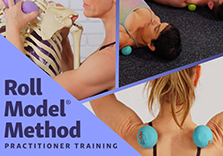
It seems that the rotator cuff muscles (SITS – suprapinatus, infraspinatus, teres minor and subscapularis) are receiving a lot of press these days, yet one of its members is often obscured from the spotlight: the subscapularis.
The largest of the four members, the subscapularis is challenging to visualize due to its location on the anterior (front) side of the scapula. Furthermore, its deep position between the shoulder blade and the ribcage makes it tricky to palpate. And although a key function of the subscapularis is to internally rotate the shoulder, there are larger neighboring muscles that also contribute to this action, making it even more elusive to actually feel for isolating it upon contraction.
With all of this obscurity, why not just skip over it and instead focus on the larger, more easily accessible neighboring internal rotators? To begin to answer that question, let’s take a closer look at the subscapularis and its function in rotator cuff muscle anatomy.

This triangularly shaped muscle originates from the medial anterior surface of the scapula and is the only rotator cuff muscle that inserts on the lesser tuberosity of the humeral head (the front portion of the upper arm bone). It fills the subscapular fossa and is sandwiched between the scapula and serratus anterior. As previously mentioned, the subscapularis internally rotates the shoulder. Also involved in creating internal rotation are the anterior fibers of the deltoid, latissimus dorsi, pectoralis major, and teres major (antagonists for internal rotation are the posterior fibers of the deltoid, infraspinatus and teres minor).
So just what makes the subscapularis so important? Why should we give this member of the rotator cuff more press, respect and even celebration?
For one, we might consider that overly tight internal rotators (including of course, the subscapularis) can inhibit our ability to externally rotate our shoulders. More importantly, however, we can find great cause for celebration of this muscle in the significant role it plays (along with the other RC muscles) in the dynamic stabilization of the shoulder. That’s an elaborate way of saying that it prevents the shoulder from dislocating. Consider that the glenohumeral joint has a greater degree of range of motion than any other joint in the body when it is fully functional and healthy. The subscapularis is essential for keeping the humerus centered in the glenoid cavity (the socket) and prevents anterior dislocation due to its insertion at the anterior lesser tuberosity. If we find our shoulders to be unstable or prone to dislocation, it’s definitely worth taking a closer look at the subscapularis. In addition to this important role of stabilization, the subscapularis makes a valuable contribution to everyday activities – such as opening a tightly sealed jar, reaching around to scratch your back, clutching a book to your chest, lifting things, throwing a fast ball, swimming the overhead stroke, and even giving a hug.
So now that we’ve come to a greater awareness of the function and importance of the subscapularis, how can we awaken, lengthen and strengthen it within our own bodies? Stay tuned for some suggestions in Friday’s post!
Take care of your shoulders. – Read the article.
Learn about our products for shoulders.
Watch our Free 5-Minute Quickfix: Shoulders Video











After reading this article I will take care of my subscapularis, because my shoulders live in internal rotation and I find working out my shoulders is not easy l get snore and my range of motion is less.
Awesome article! Subscapularis for the win. Each muscle in our body is so important and not to be overlooked. We are a chain of goodness, each muscle contains there own sweetness. Thank you for sharing!
Thank you so much for this concise and detailed review of the subscapularis, definitely left out of many conversations including internal rotation range of movement and everyday uses. Also love the SITS acronym!
As a person who has experienced nerve damage in the brachial plexus, I’m still trying to understand and propriocept — and ultimately rehabilitate — all of the muscles of my shoulders, including the subscapularis and other rotator cuff muscles. This article offers very helpful insight into the location and function of a muscle that is incredibly difficult to “experience” in real life. Thank you!
As I was reading this, I did find myself thinking that you really don’t hear a lot about the subscapularis! This will help me to remember that this too is an important muscle to pay attention to.
The pieces of the rotator cuff are finally clicking together for me! While I admit that the subscapularis was kind of off my anatomical radar, having actually felt it in our YTU training this week and now reading your articles, I think I will give more credit to this hidden muscle and the important role it plays in the health of our shoulder. Thank you!
It is an educational article about a forgotten muscles. I had a chance to experience it today in my training as we were rolling on YTU balls. It is challenging to locate but when you do, you can definitely experience pain because it is one of the overused rotator cuff muscles primarily due to our forward bend posture and spending a lot of time in front of the computer. It is good to know that if we keep this muscle healthy, we can reduce a chance of dislocating a shoulder. Thank you for emphasizing that subscapularis is important in hugging.
A tight subscapularis definitely plays an inhibiting role in creating external rotation of the humerus overhead.. Therefore, ball rolling of this area is key in accessing the biomechanical stability of a flexed shoulder. I am curious as to what movements exactly would have diagnostic value in determining a weak subscapularis?
I know this was a post focusing on the subscapularis however it was you mention of the anterior deltoid that perked my interest even more! I have pain when I extend and internally rotate my shoulder (like scratching the middle of my back), I have bee researching and exploring the subscapularis but now that you mention it, most of my discomfort/pain is felt in the anterior deltoid… hummmm… The awareness of how the rotator cuff muscles work together to create balance and stability in the glenohumeral joint is vital in my exploration as well, thank-you for that.
Instead of celebrating my subscapularis I want to see what this muscle is doing that contributes to my melange of overly strong internal rotators muscles. Anything beyond shoulder flossing you would recommend to open those up?
[…] towards your ears and rolling forward toward your computer keyboard). He also had extremely tight internal rotators (the muscles that help you to hold your arms on your computer mouse and on your keyboard for hours […]
I do a lot of swing and salsa dancing, which leaves my rotator cuff vulnerable when I’m with a poor partner/leader. I am going to look into doing some more proactive work with my subscapularis to prevent some of these injuries. Thanks!
I will admit that I was under appreciating the subscapularis. It is always the muscle forgotten when I would think about the rotator cuff. Thanks to your acronym SITS that won’t happen anymore! Also I think it is so amazing that the subscapularis helps prevent the shoulder from dislocating and in everyday movements like giving a hug 🙂
Thanks Elissa for posting this!
I now have a crystal clear picture of what the subscapularis does. Since it is tough to palpate and locate as you mentioned; it is often forgotten. Your examples of everyday use are great and are motivation for awakening this great muscle.
Wow, I just had a lightbulb moment reading your blog. I have a shoulder that dislocates quite easily (I used to do it to both shoulders as a party trick when I was a kid) and I have been so focused on overused supraspinatus and underused infraspinatus that I had forgotten about subscapularis’s role in the matter. I am so glad that I read this, thank you! I can’t wait to excavate with a therapy ball to see how the tissues are feeling too.
Great article shedding light on a little known issue! While I was already aware of the anatomy of rotator cuff muscles, only recently in a YTU class, did i discover that the discomfort in my R shoulder seems to be a compensation pattern. Apparently I have limited shoulder external rotation, compensate with retraction; creating a cascade of dysfunction. Bottom line is that I now to realize that tightness of my subscapularis is definitely involved in the root cause. It is critical that I use my YTU Therapy balls and do some dynamic shoulder movements to balance the tissue tension and strength for a healthier shoulder rotation, creating safer stabilization and performance. Thanks!
I am so into the Subscapularis right now. Just like Elissa said, it is quite the forgotten Rotator Cuff muscles, not to mention Tadasana muscle. I have just begun to understand this muscle and I had no idea that this muscle was keeping me from externally rotating in my Glenohumeral joint and allowing for more ease in standing erect. When I was a kid I really looked up to ballerinas and the broadness of their Clavical as the skin swam across the surface of their chest for days…unfortunately I was not aware of the importance of releasing the tension in my subscapularis which resulted in a noticeable shortening in the front of my body and a caving in of shoulders towards my anterior body.
I agree with you Yelimar! I didn’t really understand the role Subscap played being part of the rotator cuff until reading both of these articles. Thanks for the write up Elissa, I’m go look for that work out post now, that you spoke about. Again well written, solid content, and easy to follow-stoked I clicked on your name.
Thanks for sharing this! I had no idea this was the muscle that kept the shoulder from dislocating. When a shoulder does dislocate, is it due to too much laxity in the subscapularis? I am in the YTU and I feel I have a better grasp of this muscle now thanks to this article. You made it easy to read and understand.
Great article! Such a powerful player in the RC muscles, thank you for giving it some recognition:)